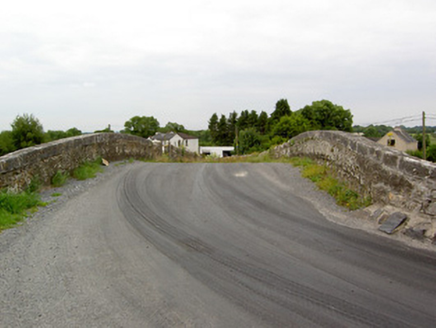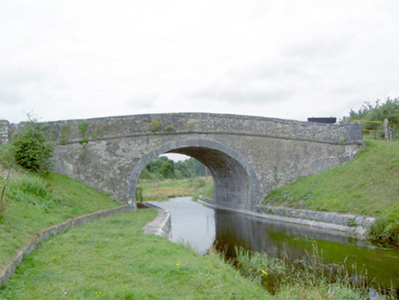Survey Data
Reg No
13402705
Rating
Regional
Categories of Special Interest
Architectural, Technical
Original Use
Bridge
In Use As
Bridge
Date
1810 - 1820
Coordinates
216917, 258415
Date Recorded
27/07/2005
Date Updated
--/--/--
Description
Single-arch humpbacked canal bridge carrying road over Royal Canal, built c. 1815. Round/elliptical-headed arch with dressed ashlar limestone voussoirs and dressed ashlar limestone masonry to barrel. Roughcast rendered spandrel walls, over rubble stone construction, having cut limestone string course at road/deck level. Roughcast rendered parapets, over rubble stone construction, to parapets, with curving ends terminated in dressed ashlar limestone piers (on square-plan). Dressed limestone coping over parapet walls. Towpath to south bank of canal with dressed limestone retaining walls to canal banks (north and south). Wrought-iron turnstile gate to the southwest end of arch, to towpath. Located to the northeast of Ballymahon.
Appraisal
A typically well-built canal bridge, which is a valuable part of the extensive canal-related built and industrial heritage of County Longford. Although humble in form, this structure has a simple and functional elegance. It is robustly built in good-quality masonry, which is testament to the long-term ambitions of the Directors General of Inland Navigation (who took over responsibility for the Royal Canal following the dissolution of the Royal Canal Company in 1813) at the start of the nineteenth century. It was probably built to designs by John Killaly (1766 – 1832), the engineer responsible for the construction of the Royal Canal between Coolnahay to Cloondara, which started in 1814 and was completed in 1817 (28 years after the canal work was started in Dublin). The main contractors involved were Henry, Mullins and McMahon. This bridge is an interesting feature in the rural landscape to the northeast of Ballymahon and is an integral element of the built heritage of the local area. A Royal Canal parcel office (Ordnance Survey first edition six-inch map 1838) was located to the west side of this bridge, now demolished. Apparently, canal passengers alighted here to catch the Bianconi coach to Athlone from c. 1817 – 1850. This bridge was the scene of a murder in 1867, when an Andrew Waters was killed here.













